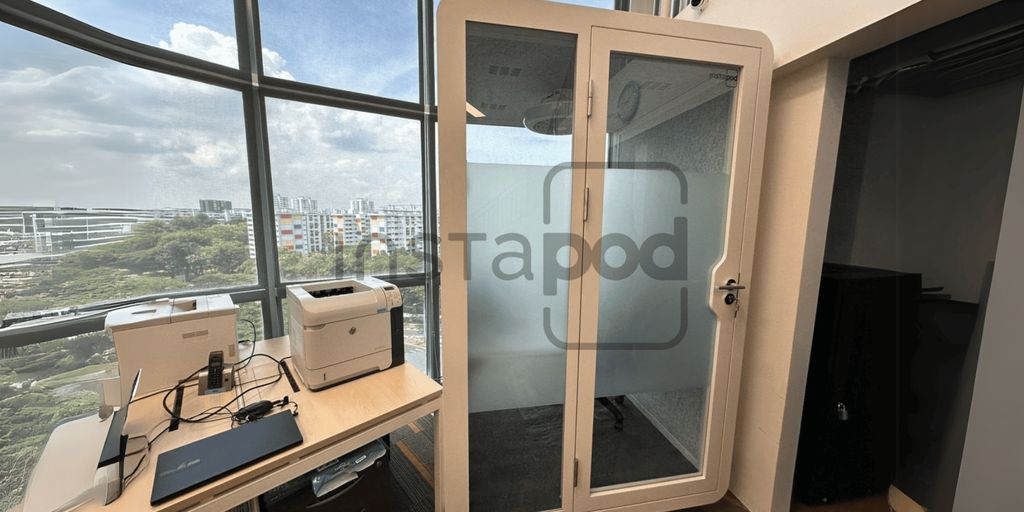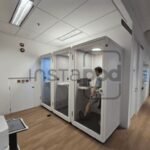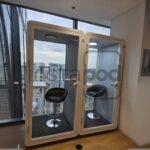No pods added to your quote request yet. Add some now for a free quote!
Ever wonder why some places feel super quiet, even when there’s a bunch of noise outside? It’s not magic, it’s all about how they’re built, especially when we’re talking about a sound proof pod. These little quiet zones are popping up everywhere, from busy offices to home studios. But what actually makes them work? Let’s dig into the basic stuff that makes a sound proof pod really good at keeping things quiet.
Key Takeaways
- Making a sound proof pod involves understanding how sound moves around. It’s about stopping sound waves from getting in or out.
- Picking the right stuff is a big deal. Heavy materials are good for blocking sound, and soft, squishy ones soak it up.
- Think about what you’ll use the sound proof pod for. A recording studio needs way more quiet than a simple office space.
- Insulation isn’t just for keeping warm; it’s super important for making a sound proof pod quiet.
- New ideas like special sound-canceling tech and strong, light materials are making sound proof pods even better.
The Science of Soundproof Pod Construction
Understanding Sound Wave Manipulation
So, how do these soundproof pods actually work? It’s all about messing with sound waves. The goal is to prevent sound from easily traveling in or out of the pod. Think of it like trying to stop water – you need barriers and ways to absorb the impact. Soundproofing uses a mix of techniques to achieve this, focusing on how sound behaves as a wave. Understanding sound absorption is key to designing an effective pod.
The Importance of Material Mass and Damping
Mass and damping are super important. Heavier materials, like thick drywall or concrete, are better at blocking sound because sound waves have a harder time passing through them. Damping materials, on the other hand, absorb sound energy and turn it into heat, reducing vibrations. It’s like a one-two punch against noise!
Here’s a simple comparison:
| Material | Mass | Damping | Sound Blocking | Sound Absorption |
|---|---|---|---|---|
| Thin Plywood | Low | Low | Poor | Poor |
| Thick Concrete | High | Low | Excellent | Poor |
| Acoustic Foam | Low | High | Poor | Excellent |
| Mass-Loaded Vinyl | High | High | Good | Good |
Decoupling Techniques for Optimal Isolation
Decoupling is a fancy word for separating structures to stop sound from traveling through them. Imagine a drum set attached directly to your wall – you’d hear every beat! Decoupling uses things like resilient channels or isolation clips to create a gap between the pod’s walls and the building’s structure. This minimizes vibration transfer, making the soundproof meeting pods way more effective.
Think of sound like a sneaky house guest. It’ll find any crack or opening to get in. Decoupling is like locking all the doors and windows, making it much harder for the sound to intrude. It’s a critical step in achieving true sound isolation.
Choosing the Right Materials for Soundproofing
Selecting the correct materials is super important if you want your soundproof pod to actually work. Different materials do different things when it comes to sound – some block it, some absorb it, and some just let it right through. It’s all about picking the right combo for your specific needs.
Dense Materials for Effective Sound Blocking
Dense materials are your best bet for blocking sound. Think of it like this: the heavier the material, the harder it is for sound waves to pass through. Concrete and lead are great examples, but they’re not always practical because they’re heavy and can be expensive. A more common approach is to use multiple layers of drywall, sometimes with a special damping compound in between. This adds mass without making the pod weigh a ton. Here’s a quick comparison:
| Material | Density (kg/m³) | Sound Blocking Ability | Cost |
|---|---|---|---|
| Concrete | 2400 | Excellent | High |
| Lead | 11340 | Excellent | Very High |
| Standard Drywall | 800 | Fair | Low |
| Damped Drywall | 850 | Good | Medium |
Acoustic Panels for Sound Absorption
While dense materials block sound, acoustic panels absorb it. These panels are usually made from foam, mineral wool, or fiberglass. They’re designed to trap sound waves and convert them into heat, which reduces echo and reverberation inside the pod. This is especially important for recording studios or any space where clear audio is a must. You can stick them on the walls and ceilings to soak up sound. They come in all sorts of shapes, sizes, and colors, so you can find something that fits your style.
Resilient Channels and Isolation Clips
These are the unsung heroes of soundproofing. Resilient channels and isolation clips are used to decouple the drywall from the framing of the pod. This means that vibrations can’t easily travel through the structure, which significantly reduces sound transmission. It’s like creating a floating wall. They’re not always necessary, but if you’re serious about soundproofing, they’re worth considering. They’re especially useful for blocking low-frequency sounds, which are notoriously difficult to deal with.
Think of soundproofing like building a fortress. You need thick walls (dense materials) to block the enemy (noise), but you also need to absorb any stray shots (acoustic panels) and make sure the walls aren’t connected to the ground (resilient channels) so the enemy can’t tunnel in. It’s all about layering different techniques to create a truly soundproof space.
Key Considerations for Effective Soundproofing
Intended Use and Required Sound Isolation Levels
Okay, so you’re thinking about a soundproof pod. Cool! First thing’s first: what are you actually going to use it for? A pod for belting out karaoke tunes needs way more sound isolation than one where you just want to take a few calls. Think about it – a recording studio needs to block out almost all external noise, while a quiet office nook just needs to dampen the distractions a bit.
- Recording Studio: High isolation, focusing on blocking all external noise.
- Office Pod: Moderate isolation, reducing distractions for calls and focused work.
- Gaming Pod: Medium isolation, containing gaming sounds and blocking external disturbances.
Assessing External Noise Sources
What kind of noise are you trying to block out? Is it the neighbor’s dog, the street traffic, or just chatty coworkers? Knowing your enemy is half the battle. Low-frequency sounds (like bass) are harder to block than high-frequency sounds (like voices). You might need different materials or construction techniques depending on what you’re up against. For example, if you’re near a busy road, you’ll need to think about office partitions that can handle low-frequency rumble.
Ventilation and Lighting for Comfort
Don’t forget the basics! A soundproof pod is useless if it’s stuffy and dark. You need proper ventilation to keep the air fresh and lighting so you can actually see what you’re doing. Think about how you’ll get fresh air in without compromising the soundproofing. Maybe a modern meeting pod with a built-in ventilation system? And consider LED lighting to keep things bright without generating too much heat.
It’s easy to get caught up in the technical aspects of soundproofing, but remember that comfort is key. A well-ventilated and lit pod will be a much more pleasant and productive space to use.
The Role of Insulation in Soundproof Pod Construction
Insulation isn’t just about keeping things warm; it’s a big deal for soundproofing too. Regular insulation, like fiberglass, helps with temperature, but for serious sound blocking, you need more. Let’s look at how insulation steps up the soundproofing game.
Beyond Thermal Benefits: Acoustic Insulation
Insulation does more than just keep heat in or out. Acoustic insulation is specially designed to absorb sound waves, reducing noise transmission. It’s like a sponge for sound, soaking up the vibrations that would otherwise pass through walls and ceilings. This is super important in a soundproof pod where the goal is to keep sound contained.
High-Density Insulation for Superior Performance
When it comes to soundproofing, density matters. High-density insulation is better at blocking sound because it’s heavier and more compact. Think of it like this: a thick, heavy blanket is better at blocking out light than a thin one. The same goes for sound. Materials like mineral wool or dense fiberglass are great choices for office phone booths because they offer superior sound reduction compared to standard insulation.
Mass-Loaded Vinyl for Enhanced Noise Reduction
Mass-loaded vinyl (MLV) is a heavy, flexible material that’s often used in soundproofing projects. It adds mass to walls and ceilings, which helps to block sound transmission. MLV is particularly effective at blocking low-frequency sounds, like traffic noise or bass from music. It’s often used in combination with other insulation materials to create a really effective sound isolation barrier.
Think of insulation as a key ingredient in a soundproof pod recipe. It works with other materials and techniques to create a space where sound is controlled and contained. Without proper insulation, even the thickest walls won’t be enough to keep the noise out.
Advanced Techniques in Soundproof Pod Design
Active Noise Control Systems
Active Noise Control (ANC) is a pretty cool tech that’s making its way into soundproof pod design. Basically, it uses microphones and speakers to listen for unwanted sounds and then creates opposite sound waves to cancel them out. It’s like noise-canceling headphones, but for a whole pod! This is especially useful for getting rid of specific annoying frequencies. It’s not perfect for all sounds, but it can really help.
Vibration Isolation Systems
Another thing that can ruin the sound isolation of a pod is vibration. If the pod is connected to a vibrating floor or wall, that vibration turns into noise inside. Vibration isolation systems use special mounts and pads to stop those vibrations from getting through. Think of it like shock absorbers for sound. These systems are super important if you’re putting a pod near machinery or in a busy office where people are walking around a lot.
Innovative Composite Materials
Materials science is always coming up with new stuff, and that includes materials for soundproofing. We’re seeing more and more composite materials that are lightweight but also really good at blocking sound. These materials might combine different layers of stuff, like dense materials with damping materials, to get the best of both worlds. They can make the pods lighter and easier to move, while still maximizing space efficiency and keeping the noise out.
It’s important to remember that no single technique is a magic bullet. The best soundproof pods use a combination of these advanced techniques, along with good old-fashioned soundproofing principles, to create a truly quiet space.
Case Studies: Successful Soundproof Pod Projects
High-End Recording Studio Isolation
One compelling example involves a high-end recording studio situated in a bustling urban area. The primary challenge was to isolate the studio from significant external noise. The solution involved using dense concrete blocks for the walls, coupled with specialized acoustic panels. This combination created an environment that not only met the stringent industry standards for sound quality but also provided a comfortable and inspiring space for musicians and producers.
Corporate Office Quiet Zones
Many companies are now using soundproof pods to create quiet zones. One example is a corporate office that wanted to provide employees with private spaces in an open-plan layout. They installed modular work pods featuring acoustic glass walls and advanced insulation. This allowed employees to have focused work areas without disrupting the office’s overall aesthetic. The project demonstrated how thoughtful design and material choices can boost employee satisfaction and productivity by addressing noise issues.
Enhancing Productivity with Soundproof Pods
Soundproof pods are becoming increasingly popular in modern workplaces. Here’s why:
- Reduced distractions lead to better concentration.
- Private spaces for calls and meetings improve communication.
- Improved employee well-being contributes to higher job satisfaction.
The implementation of soundproof pods, such as an office pod singapore, has shown a measurable increase in employee output and a decrease in stress levels, according to internal surveys conducted before and after installation. This highlights the direct correlation between a quieter workspace and enhanced productivity.
Another example is the use of a work booth in a library. The library was able to provide a quiet study space for students without having to build a separate room.
Future Innovations in Soundproof Pod Construction
The world of soundproof pods is about to get a whole lot more interesting. We’re not just talking about thicker walls; we’re looking at some serious tech and material upgrades that could change how we think about quiet spaces. It’s an exciting time to be in the noise-reduction game.
Sustainable Materials and Production
Let’s be real, construction isn’t exactly known for being eco-friendly. But that’s changing, and soundproof pods are part of the shift. Expect to see more pods built with recycled materials, plant-based foams, and sustainably sourced wood. Companies are also exploring ways to reduce waste during the manufacturing process. It’s all about making quiet spaces without making a lot of noise for the planet. For example, consider the following:
- Using recycled denim for insulation.
- Employing bamboo for structural components.
- Developing biodegradable acoustic panels.
Smart Technology Integration
Imagine a soundproof pod that adapts to its environment. That’s the promise of smart tech integration. Smart sensors could monitor noise levels and adjust the pod’s settings in real-time. Think automatic ventilation adjustments, active noise cancellation that targets specific frequencies, and even lighting that changes based on the pod’s use. It’s like having a personal sound engineer built into your workspace.
The integration of smart technology will not only optimize acoustic performance but also enhance user comfort and convenience. This includes features like voice-activated controls, personalized sound profiles, and remote monitoring capabilities.
Adaptive Acoustic Environments
What if your soundproof pod could change its acoustic properties on demand? That’s the idea behind adaptive acoustic environments. By using adjustable acoustic panels and electronic sound shaping, office pods could be optimized for different activities. Need a quiet space for focused work? The pod adjusts to minimize distractions. Want to use it for a virtual meeting? The acoustics shift to enhance speech clarity. It’s all about creating a versatile space that meets your changing needs. Here’s a quick look at potential adjustments:
| Scenario | Acoustic Adjustment |
|---|---|
| Focused Work | Increased sound absorption, reduced reverberation |
| Virtual Meeting | Enhanced speech clarity, balanced sound distribution |
| Relaxation/Meditation | Softened acoustics, calming soundscapes |
It’s not just about blocking out noise; it’s about creating the perfect sound environment for whatever you’re doing. The future of office design is looking pretty quiet, and pretty smart.
Wrapping It Up
So, there you have it. Making a soundproof pod really works because of a few simple things. It’s about using the right stuff, putting it together well, and thinking about how sound moves. When you get these things right, you end up with a quiet space that does what it’s supposed to. It’s pretty cool how much of a difference a well-made pod can make, whether it’s for work or just some peace and quiet.
Frequently Asked Questions
What exactly is a soundproof pod?
A soundproof pod is a special, enclosed space made to greatly lower how much sound gets in or out. People often use them for private calls, meetings, or just to focus in busy offices.
What are the key parts that make up a soundproof pod?
The main parts of a soundproof pod include materials that soak up sound, tight seals to keep air (and sound) from leaking, double-pane windows, and heavy, thick construction stuff to block noise.
What kinds of materials are usually used for soundproofing in these pods?
Common materials used to make soundproof pods include soft acoustic panels, heavy vinyl sheets, special soundproofing curtains, and thick fiberglass insulation. These are picked because they’re good at either absorbing or stopping sound waves.
How do soundproof pods actually stop noise from getting through?
Soundproof pods cut down on noise by doing a few things: they absorb sound, block sound, and are built to be airtight. Materials inside the pod soak up echoes, while the tight seals and heavy building parts stop sound from traveling through.
What should I think about when designing a soundproof pod?
When you’re planning a soundproof pod, you need to think about what it will be used for, how quiet it really needs to be, its size and layout, and what it should look like and how people will use it. It’s important to balance all these things to make a pod that works well and is comfortable.
Are soundproof pods really effective at blocking noise?
Yes, soundproof pods are very effective! They can significantly reduce noise, creating a quiet space even in loud environments. Their effectiveness depends on the quality of materials and how well they are built.




